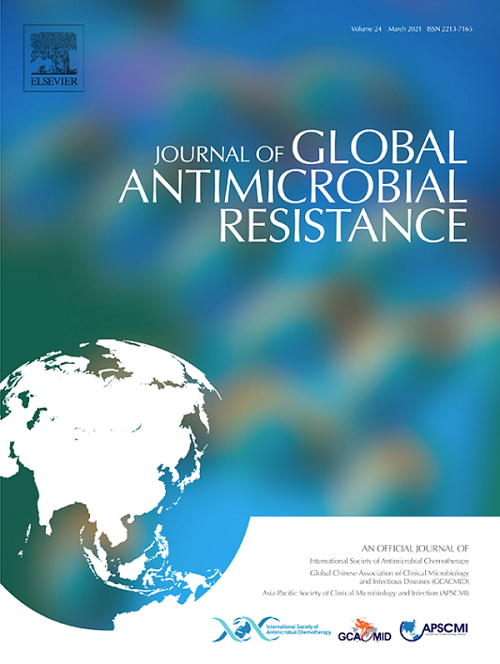氨曲南与乐巴坦联用对产生丝氨酸和金属β-内酰胺酶的革兰氏阴性病原菌的体外活性研究。
IF 3.7
3区 医学
Q2 INFECTIOUS DISEASES
引用次数: 0
摘要
由于治疗方案有限,产碳青霉烯酶革兰氏阴性病原体引起的感染已成为全球公共卫生的重大挑战。产生金属β-内酰胺酶的病原体尤其成问题,因为它们不受传统β-内酰胺酶抑制剂的抑制。在此,我们评估了氨曲南与乐巴坦联合使用对产生碳青霉烯酶的微生物的体外活性,包括在日本常见的产生丝氨酸-β-内酰胺酶和imp型金属-β-内酰胺酶的菌株。方法:采用119株产碳青霉烯酶临床分离株进行研究。采用微量肉汤稀释法测定氨曲南、亚胺培南单用及氨曲南/乐巴坦、氨曲南/阿维巴坦、亚胺培南/乐巴坦联用的最低抑菌浓度(mic)。结果:除IMP型、NDM型、ges型或OXA-48碳青霉烯酶外,对产生ESBL或AmpC的菌株以及窄养单胞菌,氨曲南/乐曲南联合使用的mic均显著低于氨曲南单独使用的mic,在IMP、NDM和窄养单胞菌中,氨曲南/乐曲南联合使用的mic也显著低于氨曲南单独使用的mic。肺炎克雷伯菌和肠杆菌,其中许多同时产生金属β-内酰胺酶和丝氨酸β-内酰胺酶。与阿曲南/阿维巴坦联合用药相比,阿曲南/瑞乐巴坦联合用药具有较高的mic。结论:瑞巴坦的加入有可能恢复氨曲南对产生金属β-内酰胺酶和丝氨酸β-内酰胺酶的菌株的活性。这种组合可能在无法获得头孢他啶-阿维巴坦的国家治疗这些菌株引起的感染方面发挥作用。本文章由计算机程序翻译,如有差异,请以英文原文为准。
In vitro activity of aztreonam in combination with relebactam against gram-negative pathogens producing various serine and metallo-β-lactamases
Objectives
Infections caused by carbapenemase-producing Gram-negative pathogens have become a significant global public health challenge due to limited treatment options. Pathogens producing metallo-β-lactamase are particularly problematic since they are not inhibited by conventional β-lactamase inhibitors. Herein, we assess the in vitro activity of aztreonam in combination with relebactam against a collection carbapenemase producing organisms, including strains producing both serine‑β-lactamase and IMP-type metallo-β-lactamase that are commonly encountered in Japan.
Methods
A total of 119 carbapenemase-producing clinical isolates were used in this study. Minimum inhibitory concentrations (MICs) of aztreonam and imipenem alone and aztreonam/relebactam, aztreonam/avibactam and imipenem/relebactam combinations were determined by the broth microdilution method.
Results
Aztreonam MICs were reduced in combination with relebactam for strains producing ESBL or AmpC in addition to IMP-type, NDM-type, GES-type or OXA-48 carbapenemases and for Stenotrophomonas spp. Additionally, aztreonam/relebactam combination MICs were significantly lower than MICs of aztreonam alone among IMP producers, NDM producers and Stenotrophomonas spp. Significant differences between aztreonam/relebactam and aztreonam MICs were also observed for strains of E. coli, K. pneumoniae and Enterobacter spp., many of which produced both metallo-β-lactamase and serine‑β-lactamase. The aztreonam/relebactam combination showed comparable to higher MICs compared with the aztreonam/avibactam combination.
Conclusion
The addition of relebactam has a potential to restore the activity of aztreonam against strains that produce metallo-β-lactamase and serine‑β-lactamase. The combination may have a role in the treatment of infections due to these strains in countries without access to ceftazidime-avibactam.
求助全文
通过发布文献求助,成功后即可免费获取论文全文。
去求助
来源期刊

Journal of global antimicrobial resistance
INFECTIOUS DISEASES-PHARMACOLOGY & PHARMACY
CiteScore
8.70
自引率
2.20%
发文量
285
审稿时长
34 weeks
期刊介绍:
The Journal of Global Antimicrobial Resistance (JGAR) is a quarterly online journal run by an international Editorial Board that focuses on the global spread of antibiotic-resistant microbes.
JGAR is a dedicated journal for all professionals working in research, health care, the environment and animal infection control, aiming to track the resistance threat worldwide and provides a single voice devoted to antimicrobial resistance (AMR).
Featuring peer-reviewed and up to date research articles, reviews, short notes and hot topics JGAR covers the key topics related to antibacterial, antiviral, antifungal and antiparasitic resistance.
 求助内容:
求助内容: 应助结果提醒方式:
应助结果提醒方式:


